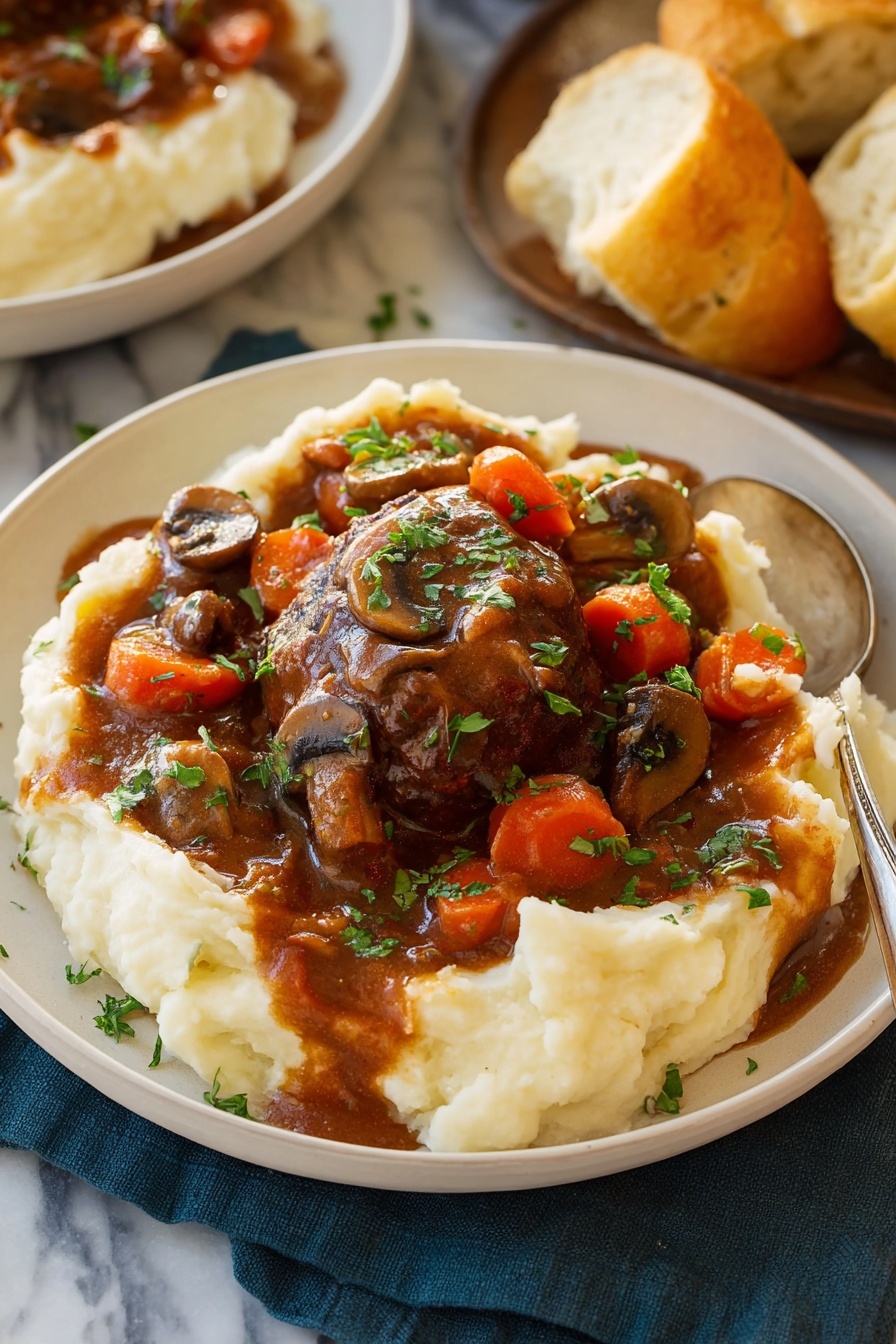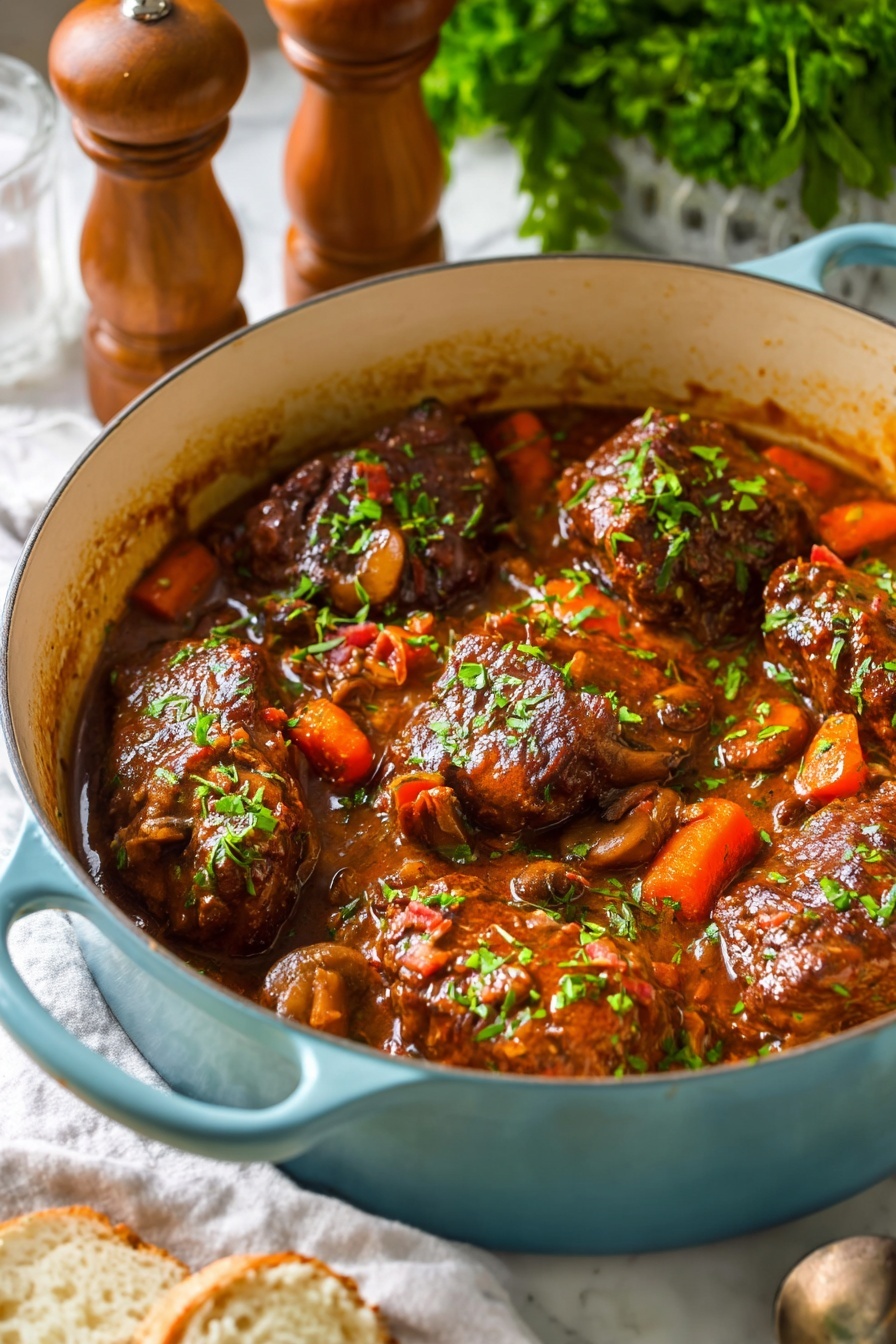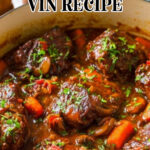There’s something truly comforting about slow-cooked dishes that fill your kitchen with rich aromas, and this Classic Coq au Vin Recipe does just that. It’s a beautiful blend of tender chicken, smoky bacon, earthy mushrooms, and herbs all celebrated in a luscious red wine sauce — worth every minute of your time in the kitchen.
Jump to:
Why You'll Love This Recipe
This Classic Coq au Vin Recipe is one of my go-to dishes for dinner parties or cozy weekend meals—it’s impressive yet approachable. Plus, the flavors deepen the longer it simmers, making every bite a rewarding experience.
- Rich, layered flavors: The combination of red wine, bacon, and fresh herbs creates a sauce that’s truly show-stopping.
- Perfectly tender chicken: Searing the thighs locks in juiciness before slow simmering until they fall off the bone.
- Relatively simple prep: Most of the ingredients are pantry staples or easy to find, so pulling it together isn’t as intimidating as it seems.
- Great make-ahead dish: Coq au vin tastes even better the next day, making leftovers a delight or prep for guests stress-free.

Ingredients & Why They Work
This recipe blends simple but powerful ingredients to create depth. The smoky bacon fat is what gives the chicken that irresistible base flavor, while the wine and herbs slowly transform the dish into a warm, mouthwatering favorite. Here’s what I look for and why each part matters.

- Bacon: Opt for good quality sliced bacon; its fat renders out and flavors the chicken and veggies beautifully.
- Chicken thighs: Dark meat is ideal here for tenderness and flavor—skin-on for crispiness during searing.
- Mushrooms: I prefer cremini for their earthiness; thick slices hold up well during the simmer.
- Onion: Yellow onion brings a subtle sweetness when sautéed alongside the garlic.
- Garlic: Fresh minced garlic adds aromatic warmth—don’t rush this step for the best flavor.
- Tomato paste: This little ingredient amps up umami and adds body to the sauce.
- Dry red wine: Pinot Noir or Côtes du Rhône work wonderfully; the wine tenderizes and flavor-infuses the chicken.
- Chicken broth: Low sodium broth lets you control seasoning and enhances the sauce's body.
- Fresh thyme and rosemary: These herbs bring that classic Provençal flair that defines coq au vin.
- Carrots: Chunky pieces add gentle sweetness and texture contrast as they cook.
- Unsalted butter and flour: Used together to thicken the sauce into a silky finish.
- Fresh parsley: Sprinkled on top just before serving to add brightness and color.
Make It Your Way
I like to tweak this Classic Coq au Vin Recipe depending on the season or who’s coming over. It’s a forgiving dish that takes well to small changes, so don’t hesitate to make it your own.
- Variation: Sometimes I swap thyme and rosemary for herbes de Provence when I want to evoke more of that south-of-France vibe—totally delicious and aromatic.
- Dietary modification: For a lighter take, you can remove the chicken skin after cooking and skip the bacon, then add a splash of soy sauce or smoked paprika to maintain some depth.
- Vegetable additions: I’ve added pearl onions or even diced celery before to amp up flavor complexity and texture.
- Wine options: Don’t stress if you don’t have Pinot Noir—any dry red with good fruitiness works well here, just avoid anything too bold or tannic.
Step-by-Step: How I Make Classic Coq au Vin Recipe
Step 1: Crisp and Render the Bacon Fat
Start by heating your pot over medium heat and add the bacon. Cooking it until just crisp releases that smoky fat essential for sautéing the rest of the ingredients. Once done, transfer the bacon to a paper towel-lined plate to drain, then pop it in the fridge to keep for later. Don’t discard the fat left behind—that’s pure flavor gold.
Step 2: Sear the Chicken Thighs
Pat the chicken thighs dry and season generously with salt and pepper. Using the bacon fat for richness, sear the thighs skin-side down until golden and crispy, about 4 minutes. Flip and brown the other side a little longer. Don’t rush this step—it locks moisture in and adds incredible taste. Do this in batches to avoid crowding the pan.
Step 3: Build Your Flavor Base with Vegetables and Tomato Paste
After removing the chicken, toss in the mushrooms and sauté for about 3 minutes. Then add the onion, cooking until translucent, around 3 more minutes. Garlic goes in next—just 30 seconds, enough to awaken fragrance without burning. Stir in the tomato paste and cook briefly, letting those flavors bloom beautifully.
Step 4: Deglaze and Simmer the Sauce
Pour in the dry red wine while scraping the browned bits off the bottom; this step ignites the sauce’s deep flavor. Add chicken broth, thyme, and rosemary, and bring everything to a gentle simmer. Lower the heat and let this bath of goodness slow cook for 10 minutes to marry the flavors.
Step 5: Add Chicken and Carrots, Then Simmer Low and Slow
Return the chicken thighs to the pot along with carrots, then cover and simmer on low for about 45 minutes. Stir gently halfway through so everything cooks evenly, and the chicken becomes melt-in-your-mouth tender.
Step 6: Thicken the Sauce and Finish Up
While the chicken bubbles away, melt butter in a small saucepan and whisk in flour, cooking it for about 1½ minutes to get rid of that raw taste. Slowly whisk in about 1½ cups of the hot liquid from your main pot until it thickens smoothly. Pour this lovely gravy back into the chicken pot, add the chilled bacon, stir well, and let everything meld for a few minutes before serving.
Top Tip
My experience with this Classic Coq au Vin Recipe has taught me that patience is everything. Rushing any step can cost precious flavor or texture. Here are some tips I wish I’d known when I first tried making it.
- Don’t skip drying the chicken: Moisture on the chicken skin makes it impossible to get that beautiful golden sear. I always pat them really dry with paper towels first.
- Use the bacon fat: Instead of adding extra oil, relying on bacon fat adds smoky depth and richness that you just can’t get otherwise.
- Scrape those browned bits: When adding wine, make sure you scrape the pan bottom well to lift all the caramelized flavor—it’s the cornerstone of the sauce.
- Thicken gradually: Whisk the flour mixture slowly into the hot liquid to avoid lumps; it’s worked perfectly for me every time I follow this step patiently.
How to Serve Classic Coq au Vin Recipe

Garnishes
I always sprinkle fresh chopped parsley on top before serving. It adds a pop of vibrant green and a fresh herbal note that brightens the deep, savory flavors of the dish. Sometimes, a few whole thyme sprigs add a rustic look if I’m plating for company.
Side Dishes
This recipe pairs beautifully with creamy mashed potatoes or buttered egg noodles, which soak up the fragrant sauce perfectly. I’ve also enjoyed it with crusty French bread to savor every last drop. For a lighter option, steamed green beans or a simple salad make a nice contrast.
Creative Ways to Present
For a special occasion, I’ve served coq au vin in individual casserole dishes—it feels elegant and personal. Layer a sprig of fresh herb on top and a few bacon pieces for a beautiful presentation. You can also plate it family-style on a large wooden board surrounded by rustic bread and a cheese platter for an inviting spread.
Make Ahead and Storage
Storing Leftovers
Leftovers of this Classic Coq au Vin Recipe store wonderfully in an airtight container in the fridge for up to 3 days. I make sure to let it cool completely before refrigerating to keep the sauce fresh and the chicken tender.
Freezing
I’ve frozen coq au vin a few times with great results. Just portion it into freezer-safe containers and thaw overnight in the fridge before reheating. The flavors actually develop more deeply after freezing!
Reheating
To reheat, I warm it gently on the stovetop over low heat, stirring occasionally until heated through. Adding a splash of chicken broth or water helps loosen the sauce if it thickened too much in the fridge.
Frequently Asked Questions:
You can use chicken breasts, but thighs are recommended because they stay moist and tender during the slow cooking. Breasts tend to dry out, so if you do use them, consider shortening the simmer time and watch carefully to avoid overcooking.
Choose a dry red wine that you enjoy drinking, such as Pinot Noir or a Côtes du Rhône, because the wine’s flavor really shines in the sauce. Avoid very tannic or heavily oaked wines, as their bitterness can overpower the dish.
Absolutely! This dish tastes even better the next day once the flavors have had time to meld. You can prepare it fully, then refrigerate and gently reheat before serving. Perfect for stress-free entertaining.
If you prefer not to use flour, you can simmer the sauce uncovered to let it reduce and thicken naturally. Alternatively, a cornstarch slurry (cornstarch mixed with cold water) works well—add it gradually and stir until the sauce reaches your desired consistency.
Final Thoughts
This Classic Coq au Vin Recipe is one of those timeless dishes that makes you feel connected to the heart of French cooking. I love sharing it with friends and family because it’s so much more than just a meal — it’s a celebration of patience, great ingredients, and simple pleasures. I hope you’ll give it a try and enjoy that little bit of magic bubbling away in your kitchen!
Print
Classic Coq au Vin Recipe
- Prep Time: 30 minutes
- Cook Time: 1 hour 30 minutes
- Total Time: 2 hours
- Yield: 8 servings
- Category: Main Course
- Method: Stovetop
- Cuisine: French
Description
Classic French Coq au Vin features tender chicken thighs slow-simmered in red wine with smoky bacon, mushrooms, onions, carrots, and aromatic herbs, finished with a luscious butter and flour sauce for a rich and comforting meal.
Ingredients
Meat and Bacon
- 6 slices (6 oz) bacon
- 8 chicken thighs (3 ½ to 4 lbs)
Vegetables
- 8 oz. cremini or white mushrooms, sliced thick
- 1 medium yellow onion, diced (1 ½ cups)
- 4 garlic cloves, minced (4 tsp)
- 3 medium carrots, peeled and chopped into 1 inch chunks
Liquids and Broth
- 2 cups dry red wine, such as Pinot Noir or Cotes du Rhone
- 2 ½ cups low sodium chicken broth, homemade or store-bought
Herbs and Seasonings
- Salt and black pepper, to taste
- 2 teaspoon chopped fresh thyme
- 2 teaspoon chopped fresh rosemary
- 2 tablespoon chopped fresh parsley, for garnish
Sauce Thickener
- 3 tablespoon unsalted butter
- 3 tablespoon flour
- 2 tablespoon tomato paste
Instructions
- Cook Bacon: Heat a large pot or braiser over medium heat and lightly spray with non-stick cooking spray. Add bacon slices and cook until just crisp. Transfer bacon to a paper towel-lined plate to drain and refrigerate. Leave bacon fat in the pot.
- Sear Chicken: Pat chicken thighs dry with paper towels and season both sides with salt and black pepper. In the same pot, add 4 chicken thighs skin side down and sear until golden brown on the bottom, about 4 minutes, then turn and brown for another 2 to 3 minutes. Transfer to a plate and repeat with remaining thighs. Set all chicken aside.
- Sauté Vegetables: Reduce heat to medium and add mushrooms, sautéing for 3 minutes. Add diced onion and sauté another 3 minutes. Stir in minced garlic and cook for 30 seconds, then add tomato paste and stir and cook for 30 seconds more.
- Deglaze and Simmer: Pour in red wine, scraping up browned bits from the bottom of the pot. Stir in chicken broth, thyme, and rosemary. Bring mixture to a simmer, then reduce heat to low and simmer gently for 10 minutes.
- Cook Chicken and Carrots: Return chicken thighs to the pot along with chopped carrots and stir to combine. Cover and simmer on low heat for 45 minutes, gently stirring once halfway through cooking.
- Make Thickening Sauce: In a small saucepan over medium heat, melt butter. Add flour and cook, stirring constantly for 1 ½ minutes to form a roux. While whisking, gradually ladle out about 1 ½ cups of the cooking liquid from the chicken pot and whisk into the roux. The mixture should thicken quickly.
- Finish Sauce and Serve: Pour the thickened sauce mixture back into the chicken pot along with the cooked bacon pieces and stir to combine. Serve the coq au vin garnished with fresh chopped parsley over the top.
Notes
- If you avoid eating chicken skin, you can reduce the calorie content accordingly since nutrition estimates include skin.
- Using a good quality dry red wine like Pinot Noir or Cotes du Rhone enhances the flavor.
- If the sauce is too thick, thin it out by adding a splash more chicken broth.
- Leftovers taste great the next day as flavors deepen.
Nutrition
- Serving Size: 1 serving
- Calories: 460 kcal
- Sugar: 4 g
- Sodium: 420 mg
- Fat: 28 g
- Saturated Fat: 9 g
- Unsaturated Fat: 16 g
- Trans Fat: 0 g
- Carbohydrates: 12 g
- Fiber: 2 g
- Protein: 38 g
- Cholesterol: 110 mg







Leave a Reply